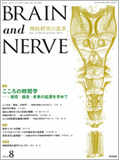Japanese
English
- 有料閲覧
- Abstract 文献概要
- 1ページ目 Look Inside
- 参考文献 Reference
Ⅰ.背景
読者の多くは,デジタル式のストップウォッチをちょうど1.00秒で押すことに挑戦した経験があると思う。何度か練習するうちに,これがほぼできるようになるのは,脳に時間を測る機能が備わっているからである。また,聞き慣れた音楽を聴いているときに,テンポやリズムの乱れを瞬時に感じ取れることからも,脳にタイミングを予測するための正確な時計があることがわかる。このように,時間情報は空間情報とともに行動の制御や外界の認知に不可欠である。時間長そのものを検出する感覚器は存在しないため,時間の知覚は脳内で作り出された内部情報を観測することによって初めて生じるものと考えられ,いわゆるメタ認知的な要素が大きい。本特集の前項まででみてきた時間に関した錯覚の多くは,こうした時間知覚の複雑性に起因するものと考えられる。
時間情報の脳内処理に関しては,それに特化したシステムがあるとする説と,感覚種や効果器のそれぞれに関した時間処理が別々に行われるとする説がある1-3)。視床下部に中枢を持つ約24時間の概日リズムなどは,前者の典型的な例である。行動制御や時間認知に必要な数百ミリ秒から数秒程度の処理については,小脳や大脳基底核などの皮質下領域と,外側前頭前野,補足運動野,運動前野,後頭頂葉などの大脳皮質領野とで構成される複数のネットワークが状況によって使い分けられていることが,神経心理学研究や脳画像研究から示唆されている1,4-6)。その一方,最近の心理物理実験では,数秒以下の時間情報は感覚種や属性,効果器などによって,ある程度独立して処理されることが示されている7)。このことは,上記の脳部位に並列のチャネルが存在することによるのかもしれないし,基本的な計時機能は各感覚系や運動系に個別に存在し,小脳や大脳基底核はそれらを非選択的に調節しているのかもしれない。
Abstract
Temporal information is essential for perception and behavior. Although the neural substrates for temporal processing have been elucidated in many different conditions, how individual neurons in each network represent time remains largely unknown. Here we review previous models of time representation in the brain, and propose that these models can be classified into four different groups based on two viewpoints. The first viewpoint is that temporal information is either prospective or retrospective. For example, the online control of movement timing requires prospective or predictive information, whereas the duration discrimination of previously presented stimuli depends on retrospective temporal information. The other viewpoint is whether neuronal coding is based on modulation of the firing rate in each neuron (rate coding) or the occurrence of synchronous activity across multiple neurons (temporal coding). The accumulator model and state-dependence model both represent time by modulating the rate of neuronal firing depending on the elapsed time, thereby providing the prospective and retrospective information, respectively. In contrast, temporal coding is used by the coincidence detection and entrainment/synchronization models acquired through learning. This classification might be helpful for comprehensive understanding of the neuronal mechanisms of temporal processing, each of which is implemented by the intrinsic property of each sensory system and/or by a dedicated network specialized for timing. We also propose a model incorporating serial stages of temporal processing to reproduce a fixed time interval, and suggest that future physiological and pharmacological experiments might prove our hypothesis.

Copyright © 2013, Igaku-Shoin Ltd. All rights reserved.


